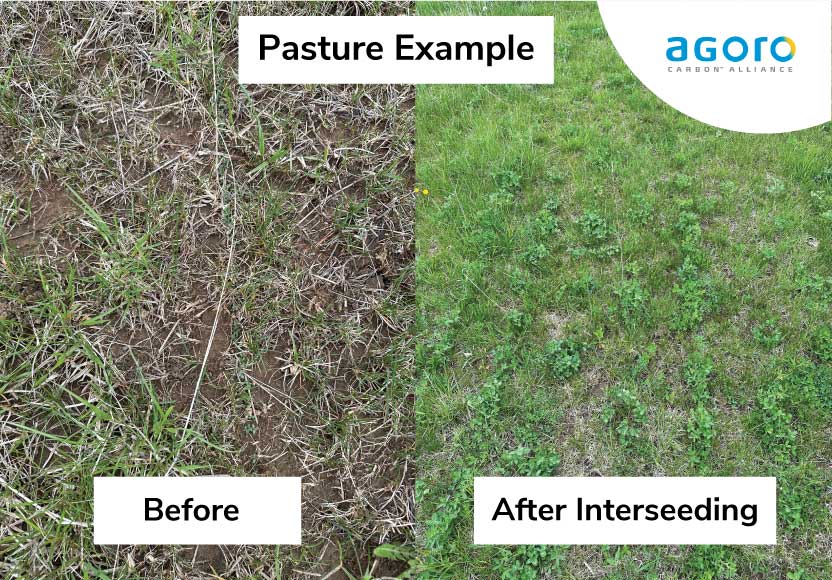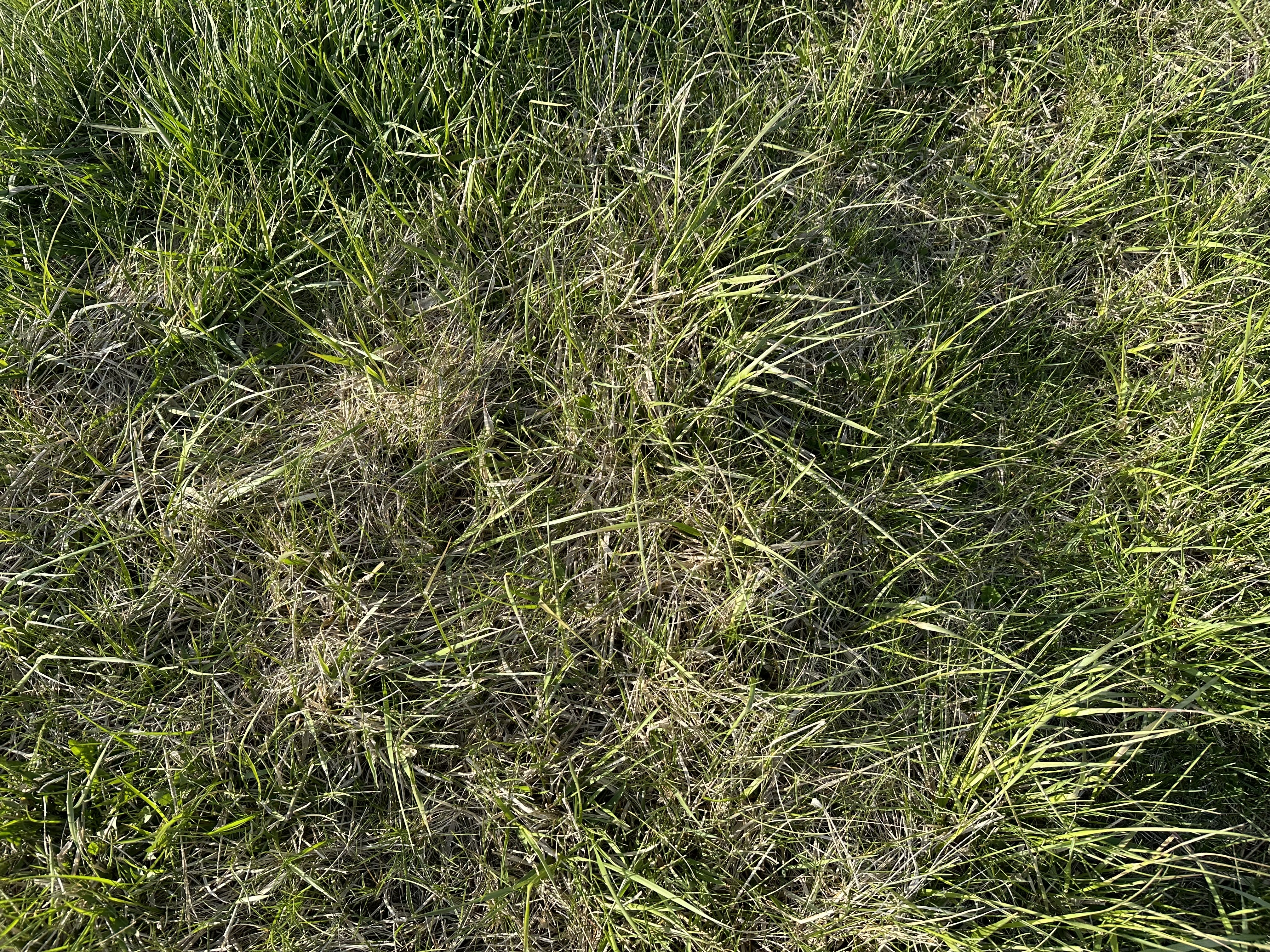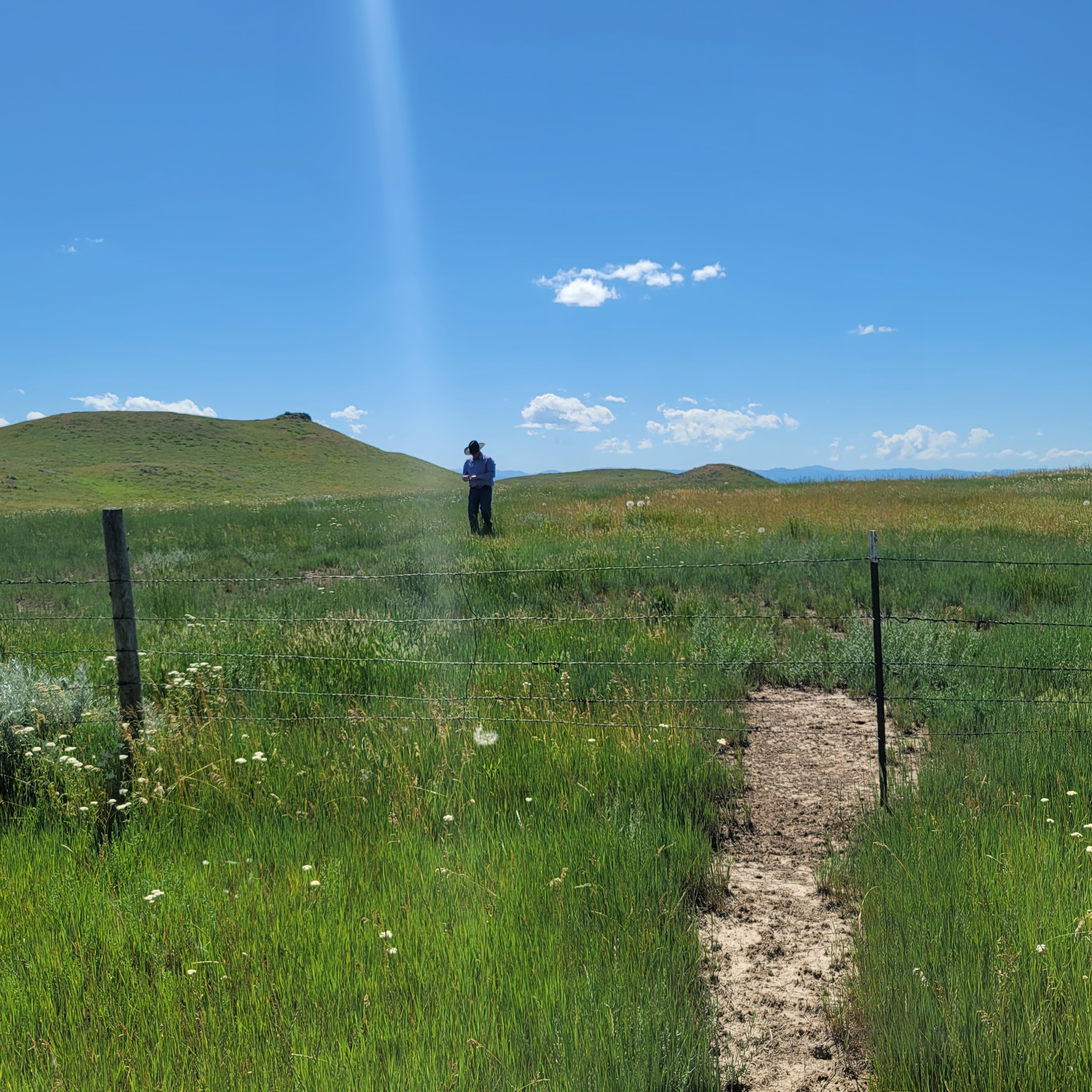Improving plant biodiversity on your ranch will often increase forage supply, forage quality, and soil health, along with carbon capture potential. Increasing plant biodiversity often comes in the form of interseeding or overseeding desirable grasses and/or legumes to change the composition or productivity of a forage base. Forbs can also be of interest but are not considered here.
Interseeding and overseeding are often used interchangeably but can have distinct management implications. Interseeding is often called “no-till seeding” or “sod seeding” because it typically incorporates a drill into seeding efforts. While overseeding usually employs frost seeding or broadcasting to establish desirable species. Regardless of what method you use, both methods of seeding are compatible with the soil health principles of maximizing soil coverage; minimizing disturbance; maintaining living plants/roots; and enhancing below and aboveground biodiversity. Either method will improve forage quality and quantity when seeded successfully.
Success will be built upon local knowledge, but in principle, involves time of seeding, type of equipment used, rate of seeding, grazing management, and species selection. It is absolutely essential that seed-to-soil contact is maximized and that competition from existing cultivated plants, as well as weed pressure, is minimized until seedlings become established. Modifying grazing or haying during establishment is also imperative for success.
 Image credit: Lisa Kubik, showing the success of interseeding on her farm
Image credit: Lisa Kubik, showing the success of interseeding on her farm
When to Seed
The timing of seeding will be dependent on the moisture and temperature regime experienced in your particular region and whether or not irrigation is available. Generally, interseeding in spring with a no-till drill, after weeds are controlled but moisture is still present and temperature is favorable, is best if irrigation is not available or moisture is limited. If supplemental water is available or soil moisture is sufficient, late summer or early fall will be best. This time presents ideal growing conditions for most selected species, reduced weed pressure, and reduced competition from existing vegetation.
Overseeding by broadcasting or frost seeding can be viable options but are often met with less success than using a drill, due to reduced soil/seed contact. Late winter in colder environments is the best time to frost seed as warm daytime temperatures and freezing nights help maximize the freeze-thaw cycle experienced in the soil, allowing the seeds broadcasted to get worked into the soil. Broadcasting will require you to increase the seeding rate roughly 1.5 times versus using a drill, depending on species chosen and site characteristics. In general, frost seeding does not work well with grasses. Broadcasting legumes with grasses is not advised due to weight differences and resultant uneven distribution. Furthermore, light grass seeds may be more likely to be caught in residue.

What Species
Perennial legume and grass selection should be based on their compatibility with existing plant species and livestock forage needs, season to be grazed or hayed, climatic conditions, soil type, and resistance to disease and insect pressure. When planting legumes, use an inoculated seed or inoculate with the proper viable strain of rhizobia immediately before planting. Select persistent species that can tolerate close grazing or trampling, such as those that spread by rhizome or stolon, in areas where animals congregate. Selecting species of similar palatability will help avoid selective grazing and improve persistence. It is important to keep in mind that some grass species are much more responsive to nitrogen and grazing pressure than others.
Legumes help add nitrogen to a system while improving the feed quality of the forage base. However, differences in dominance between grasses and legumes as well as fertility requirements should be considered. Grass, especially non-bunchgrass species that spread by rhizome (smooth bromegrass, prairie cordgrass) or stolon (i.e.bermuda and buffalo), is extremely competitive and will easily outcompete a newly seeded legume if not appropriately stunted. Fertility requirements also differ as grass needs nitrogen to reach its full potential;while legumes fix nitrogen from the atmosphere. If a mixed stand is fertilized for grass, then the vigor of the legume fraction will be reduced overtime. Legumes need to comprise over 30% of the stand to provide sufficient nitrogen for the system; otherwise nitrogen will likely be a limiting factor in forage production.
Varieties of alfalfa can differ drastically in their winter hardiness, tolerance of grazing, and drought tolerance. Some varieties, such as Ladak, are proven to be winter hardy and drought tolerant. While some new varieties have slightly inset crowns to resist trampling. Established alfalfa has an autotoxic effect that inhibits germination of newly seeded alfalfa. A winter hardy red clover that establishes rapidly is a good choice for frost seeding. Birdsfoot trefoil, cicer milkvetch and sainfoin can be good options in dry areas. They also have no risk of bloat compared to clover or other legumes, but can be a little slower to establish.
How to Establish
Controlling competition and ensuring good seed-to-soil contact are two essential steps when seeding new species, especially legumes or native grasses into domesticated, grass dominated stands. Overgrazing, chemical stunting or tilling can all be effective means to improve the likelihood of successful establishment. The approach used will be dependent on your operation, the species present and selected, as well as the landscape under consideration. Overgrazing for a period before seeding increases the odds of successful establishment. This could be done in the fall and spring prior to a spring seeding or heavy summer haying and/or grazing before fall seeding. A fairly aggressive tilling, such using a springtooth harrow or a light disk, that does not damage or eliminate the existing stand, can be effective in handicapping the existing stand. Mowing alone has not proven itself to be effective.
Another approach is to stunt the existing vegetation with a sublethal rate of a non-selective or contact herbicide. Applications when existing vegetation is 4-6” and actively growing or in the fall after the first hard frost have proven to be successful. Glyphosate has historically been used at sublethal rates due to price, ease of use, label allowances, and availability. Use only herbicides labeled for sod suppression and watch for residual and plant back periods, and follow label instructions.
The objective of any seeding method is to place the seed ¼ to ½ inch into the soil and cover it to achieve good seed-to-soil contact. Good seed-to-soil contact is best ensured with a no-till drill. Disc-type grain drills can be used but will need to penetrate sod, provide uniform seed depth, and cover the furrow – adding weights or downward pressure can help achieve this. Harrowing or dragging before and after seeding followed by rolling or cultipacking can also be done to improve seed-to-soil contact. Grazing animals can also help incorporate seed.
Application of nitrogen fertilizer will favor the existing grasses to the detriment of new seedling establishment and should be deferred until new seedlings are established, usually 1-3 years after planting. If a legume is to be planted and phosphorus is deficient, phosphorus can be banded below or to the side of seed. If equipment is not available to accomplish this it is best to defer application until establishment.
To successfully establish newly seeded plants, weeds should be controlled before interseeding with herbicides that allow for appropriate plant backs of selected species. Another important aspect in successful establishment is the modification of your grazing plan during implementation that excludes livestock until the seeded species are established and have reached the full start grazing heights or recommended cutting heights before substantial defoliation occurs. Generally, a period of at least 6-8 months should elapse after seeding before heavy grazing resumes. If grazing must occur earlier than advised, light stocking rates are suggested or a stepwise progression of seeding fields that allows for intermittent grazing. Some light grazing or haying can be beneficial to reduce standing biomass and improve light interception and vigor of seedlings, but be aware that grazing and treading of seedlings by livestock can result in the loss of a significant number of seedlings.
After implementation, walk some of your seeded areas to evaluate establishment success. Keep in mind it can take 2-3 years, and up to 5 years for those species that have less breeding or are native, to fully establish and achieve full productivity. Take a 1’ PVC square with you to assess establishment by comparing seeding rate to plants observed in several areas. Seeding biodiversity on your ranch can substantially improve forage quality and quantity, carbon potential, soil health, livestock health, and soil water holding capacity, among other important metrics. There is a no one size fits all approach. The selection of species and implementation will differ given local context. Work with an Agoro Carbon agronomist or another trusted advisor to develop a plan that fits your ranches needs.



